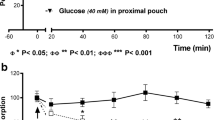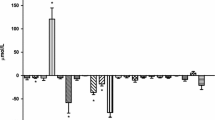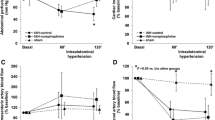Summary
The relationship of arginine-mediated release of endogenous glucagon and insulin to renal and splanchnic arterial blood flow, blood pressure, and heart rate was studied in dogs. Intravenous injection of argininehydrochloride (arg-HCl) in logarithmically increasing doses increased the concentration of glucagon (pGl) in the femoral artery from 143 ± 39 pg/ml (pre-injection) to 282 ± 49 pg/ml (following maximum dosage of arg-HCl) and insulin concentration from 23 ± 5 to 41 ± 11 µU/ml. Sodium chloride (NaCl) and urea, isovolemic and isosmolar to arg-HCl, failed to change pGl and insulin. Arg-HCl depressed arterial blood pressure from 93 ± 13 (preinjection) to 60 ± 14 mm Hg (maximum dose), NaCl increased it from 89 ± 13 to 99 ± 13 mm Hg. The blood flow increase due to arg-HCl was comparable with that due to NaCl in renal as well as in celiac and left gastric artery. The former was more pronounced in superior and inferior pancreaticoduodenal artery by 61 and 102%, and in gastroduodenal and superior mesenteric artery by 11 and 35%. Infusion of arg-HCl increased pGl from 294 ± 90 to 731 ± 200 pg/ml, and insulin from 23 ± 5 to 63 ± 18 µU/ml; the resulting blood flow increase, however, only differed in both pancreatic arteries by 10–20% from the rise during NaCl infusion where no change of pGl was observed and a decline occurred in insulin from 64 ± 21 to 27 ± 8 µU/ml. It is concluded that physiological levels of pGl have no systemic effect on arterial blood flow. A local flow increasing effect of glucagon and/or insulin on the arteries next to the pancreas is discussed.
Similar content being viewed by others
References
Aguilar-Parada E, Eisentraut AM, Unger RH (1969) Pancreatic glucagon secretion in normal and diabetic subjects. Am J Med Sci 257:415
Bashour FA, Geumei A, Nafrawi AG, Downey HF (1973) Glucagon: its effects on the hepatic arterial and portal venous beds in dogs. Pflügers Arch 344:83
Charbon GA, Hoekstra MH, Schuckink Kool D (1963) The influence of glucagon on the urinary excretion of water, sodium, potassium, calcium, magnesium, chloride, and inorganic phosphate. Acta Physiol Pharmacol Neerl 12:48
Bornhof Ch, Schwille PO (1977) Urinary sodium and calcium in various dog models and relationship to endogenous plasma glucagon. Urol Res 5:75
Hammer J, Sriussadapora S, Freis ED (1972) Effect of glucagon on heart muscle contractility. Clin Pharmacol Therap 14:56
Hulstaert PF, Beijer HJM, Brouwer FAS, Teunissen AJ, Charbon GA (1954) Glucagon: hemodynamic action related to the effect on K+ and Na+ metabolism. J Appl Physiol 37:556
Guth PH, Smith E (1976) The effect of gastrointestinal hormones on the gastric microcirculation. Gastroenterology 71:435
Kock NG, Tibblin S, Schenk WG, Jr (1970) Hemodynamic responses to glucagon: an experimental study of central, visceral, and peripheral effects. Ann Surg 171:373
Lipski JI, Kaminsky D, Sonoso E, Friedberg CK (1972) Electrophysiological effects of glucagon on the normal heart. Am J Physiol 222:1107
Lucchesi BR (1968) Cardiac actions of glucagon. Circulation Res 22:777
Renemann RS, Clarke HF, Simmons N, Spencer MP (1973) In vivo comparison of electromagentic and Doppler flowmeters: with special attention to the processing of the analogue Doppler flow signal. Cardiavasc Res 7:557
Ross G (1970) Regional circulatory effects of pancreatic glucagon. Br J Pharmacol 38:735
Said SI (1978) VIP: overview. In: Bloom SR (ed) Gut hormones. Churchill Livingstone, p 465
Saudek CD, Boulter PR, Arky RA (1973) Natriuretic effect of glucagon and its role in starvation. J Clin Endocrinol Metab 36:761
Schwille PO, Schellerer W, Reitzenstein M, Hermanek P (1974) Hyperglucagonemia, hypocalcemia, and diminished gastric blood flow—evidence for an etiological role in stress ulcer of the rat. Experientia 30:824
Stowe NT, Hock JB (1970) Role of alterations in renal hemodynamics in the natriuretic action of glucagon. Arch Int Pharmacodyn 183:65
Tibblin S, Kock NG, Schenk WG, Jr (1970) Splanchnic hemodynamic responses to glucagon. Arch Surg 100:84
Ulano HB, Treat E, Shanbour LL, Jacobson ED (1972) Selective dilation of the constricted superior mesenteric artery. Gastroenterology 62:39
Warrick M, Lin TM (1975) Action of glucagon and atropine on the mucosal blood flow of the resting fundic pouches of dogs. Life Sci 17:333
Wide L, Porath J (1966) Radioimmunoassay of proteins with the use of Sephadex-coupled antibodies. Biochem Biophys Acta 130:257
Author information
Authors and Affiliations
Rights and permissions
About this article
Cite this article
Bornhof, C., Schwille, P.O., Beijer, H.J.M. et al. Hemodynamic splanchnic and renal changes associated with administration of arginine-hydrochloride in dogs. Res. Exp. Med. 177, 57–70 (1980). https://doi.org/10.1007/BF01851633
Received:
Accepted:
Issue Date:
DOI: https://doi.org/10.1007/BF01851633




